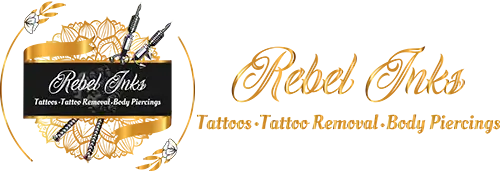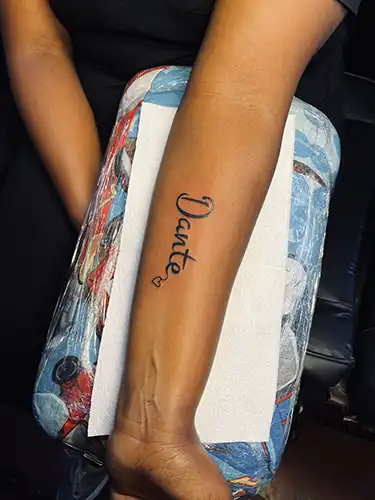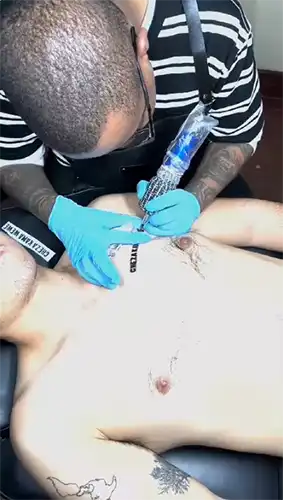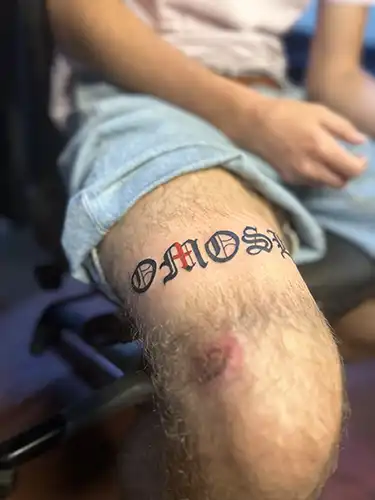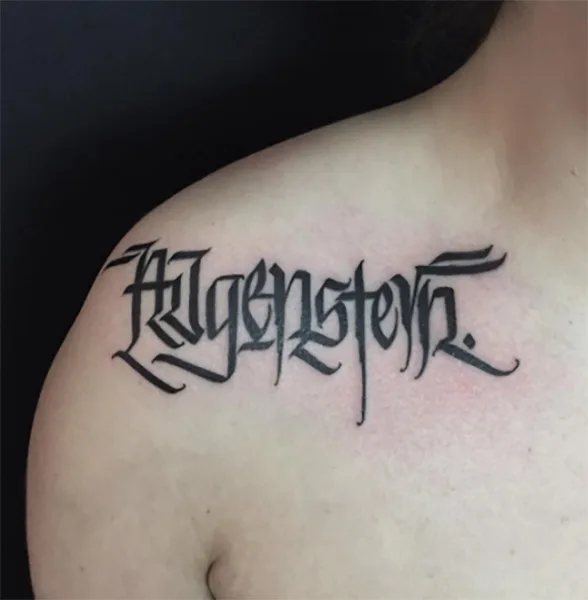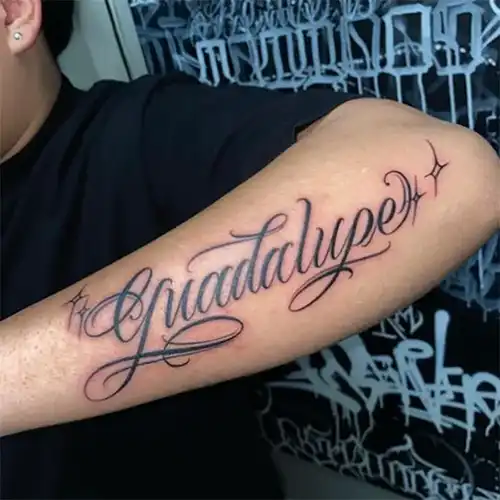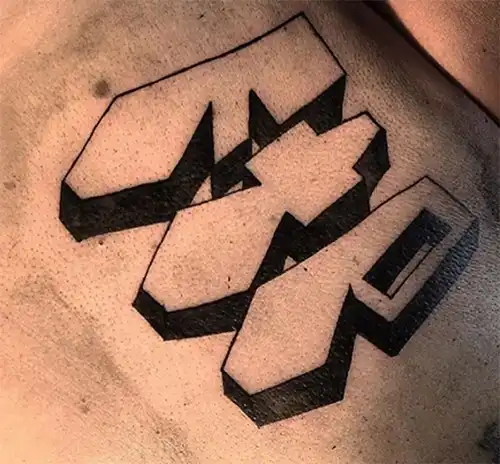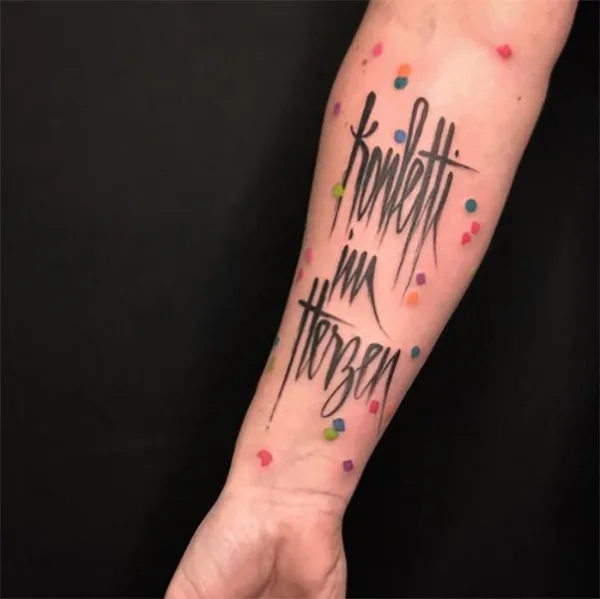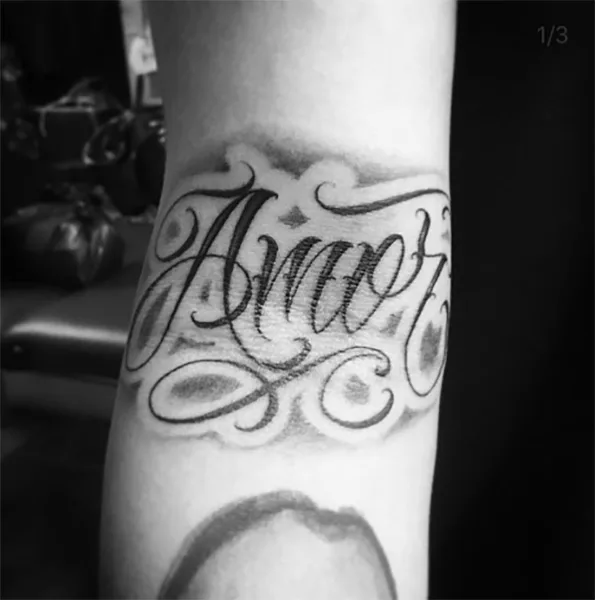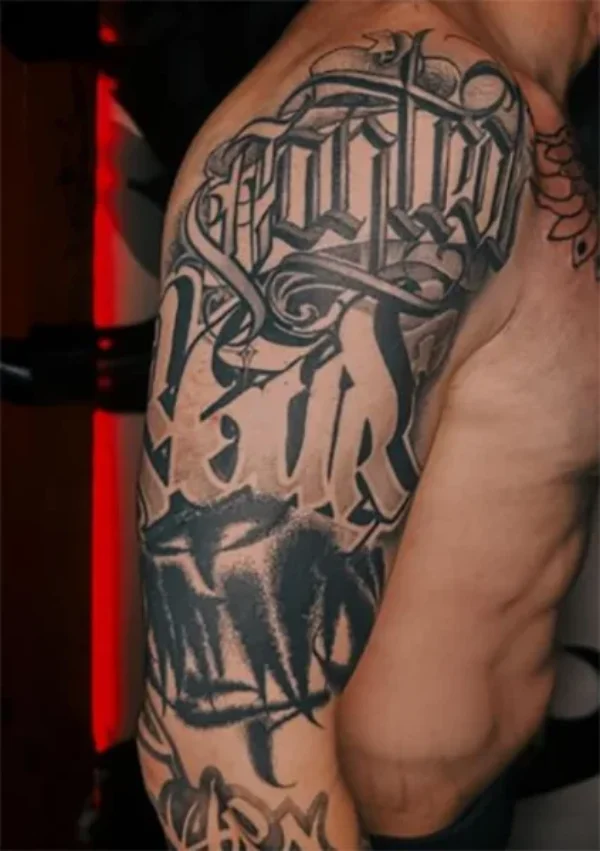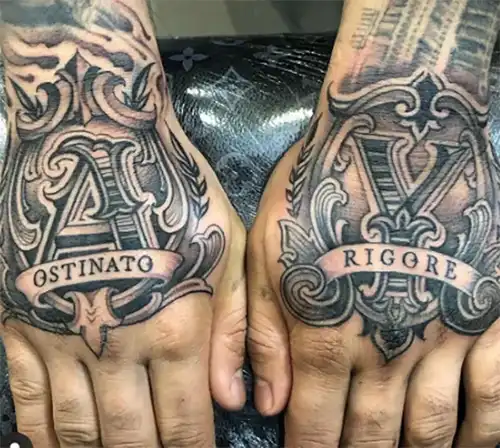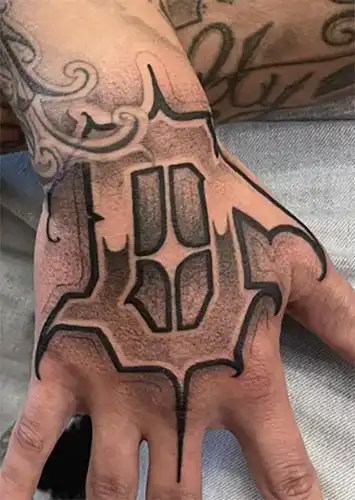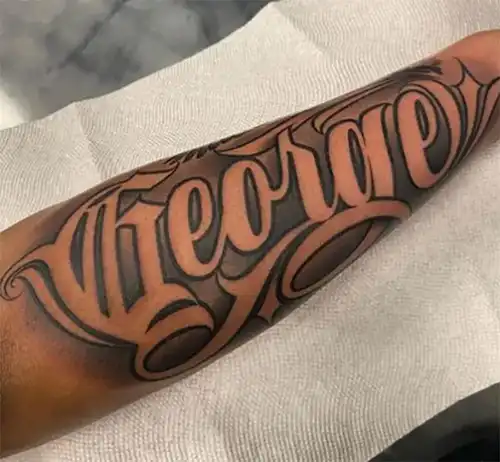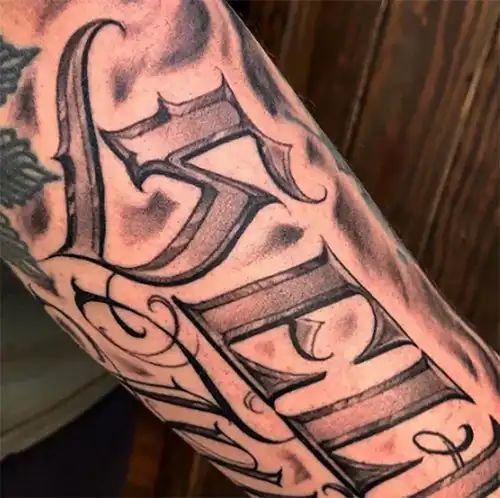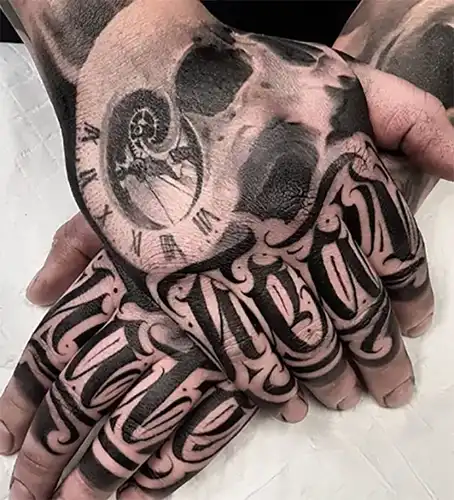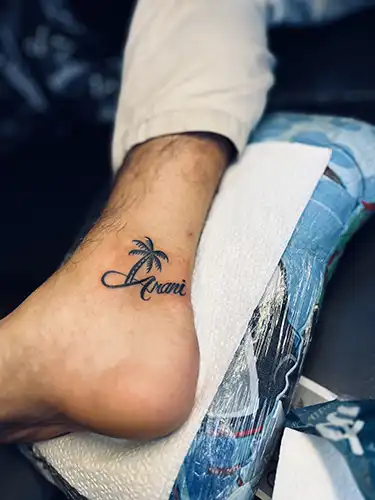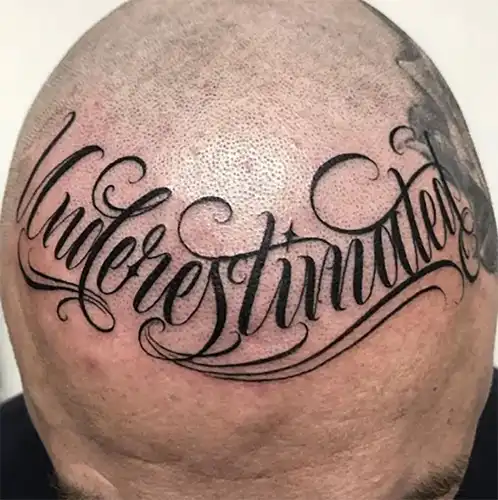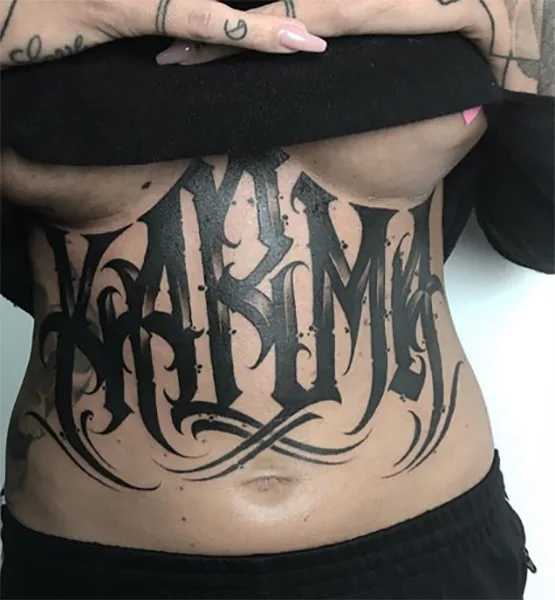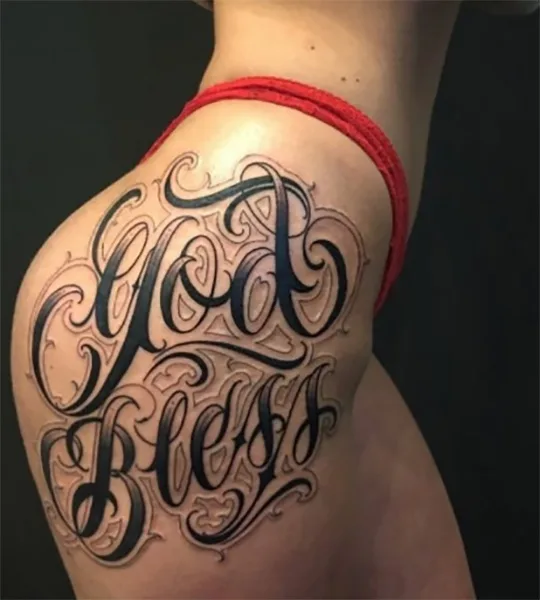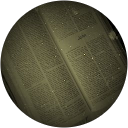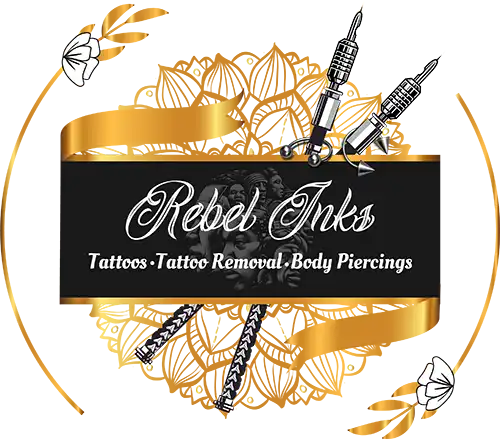Script/ Lettering Tattoos
Here are a few tips for getting a script or lettering tattoo:
- Choose the Right Font: The font you select will greatly influence the overall look and feel of your tattoo. Consider whether you want something elegant and flowing, bold and edgy, or simple and understated. Take your time to browse through various fonts and styles to find one that resonates with you.
- Keep it Meaningful: Think about the message or words you want to incorporate into your tattoo. It could be a quote, a name, a date, or even a single word that holds special significance to you. Whatever you choose, make sure it’s something that you’ll be happy to carry with you for life.
- Placement Matters: The placement of your tattoo can impact its visibility and how well it complements your body. Consider factors like pain tolerance, job requirements, and how the tattoo will age over time. Popular placements for script and lettering tattoos include the wrist, forearm, ribcage, and collarbone.
- Size and Scale: Think about the size and scale of your tattoo in relation to its placement on your body. A smaller design might work well for delicate areas, while a larger piece can make a bold statement. Our tattoo artists can help you determine the appropriate size based on your preferences and the intricacy of the design.
- Consult with a Professional: Once you’ve settled on a design concept, schedule a consultation with a reputable tattoo artist who specializes in script and lettering. Bring along any reference images or ideas you have, and be open to their suggestions and expertise. At Rebel Inks Tattoos, Tattoo Removal, and Body Piercings Parlour we have skilled artists who can help bring your vision to life and ensure that the final result exceeds your expectations.
- Prepare for the Process: Getting a tattoo is a commitment, both in terms of time and pain. Make sure you’re well-rested, hydrated, and have eaten before your appointment to help manage discomfort. Follow your artist’s aftercare instructions carefully to promote proper healing and ensure that your tattoo looks its best for years to come.
Key features of Script/ Lettering Tattoos
Script and lettering tattoos are characterized by their use of typography and textual elements as the primary design motif. Here are some key features that define script and lettering tattoos:
- Typography Styles: Script and lettering tattoos encompass a wide range of typography styles, from elegant and flowing scripts to bold and edgy fonts. Common script styles include cursive, calligraphy, old English, and brush lettering, among others. Each style conveys a different aesthetic and mood, allowing for personalization and customization.
- Word or Phrase Focus: Unlike imagery-focused tattoos, script and lettering tattoos typically center around words, phrases, quotes, or names. These textual elements serve as the focal point of the design and convey a specific message, sentiment, or meaning chosen by the wearer. The words may be in a single language or incorporate multiple languages, depending on the desired effect.
- Meaningful Content: Script and lettering tattoos often carry deep personal significance for the wearer. The chosen words or phrases may represent cherished memories, motivational mantras, philosophical beliefs, cultural heritage, or tribute to loved ones. The content of the tattoo is carefully selected to reflect the wearer’s identity, values, and life experiences.
- Customization and Individuality: While there are common script and lettering styles, each tattoo can be customized to suit the wearer’s preferences and personality. At Rebel Inks Tattoos, Tattoo Removal, and Body Piercings Parlour our tattoo artists work closely with our clients to create bespoke designs that capture their vision and aesthetic preferences. This customization may involve adjusting the font style, size, placement, spacing, and embellishments to achieve the desired look.
- Placement Variation: Script and lettering tattoos can be placed on various parts of the body, offering versatility in design placement and visibility. Popular locations include the forearm, wrist, ribcage, collarbone, back, and fingers. The choice of placement may influence the size and orientation of the tattoo, as well as its overall aesthetic impact.
- Embellishments and Accents: While the textual elements are the focal point of script and lettering tattoos, additional embellishments and accents may be incorporated to enhance the design. These can include decorative flourishes, geometric patterns, floral motifs, symbols, or illustrative elements that complement the typography and add visual interest.
- Lettering Legibility: Ensuring legibility is essential for script and lettering tattoos, especially for longer phrases or intricate fonts. At Rebel Inks Tattoos, Tattoo Removal, and Body Piercings Parlour our tattoo artists carefully consider factors such as letter spacing, line thickness, and readability to ensure that the text remains clear and coherent over time. This attention to detail helps preserve the integrity of the design and prevents distortion or blurring as the tattoo ages.
Overall, script and lettering tattoos offer a powerful means of self-expression and storytelling, allowing individuals to encapsulate their thoughts, beliefs, and emotions in a visually striking and permanent form.
Script/ Lettering Tattoos Design Style Techniques
Creating a compelling script or lettering tattoo involves a combination of design principles and artistic techniques. Here are some key design style techniques commonly used in script and lettering tattoos:
Typography Selection
Choose a typography style that complements the message and reflects the desired aesthetic. Common script styles include traditional cursive, elegant calligraphy, vintage-inspired old English, modern brush lettering, and bold geometric fonts. Each style conveys a distinct mood and personality, so select one that resonates with the intended meaning of the tattoo.
Customization
Tailor the typography to suit the wearer’s preferences and the specific context of the tattoo. Customization options may include adjusting letterforms, modifying flourishes, incorporating ligatures, or adding decorative elements. Work closely with your tattoo artist to create a bespoke design that captures the desired look and feel while maintaining legibility and coherence.
Composition
Pay attention to the layout and composition of the text within the tattoo design. Experiment with different arrangements, alignments, and spacing to create visual balance and harmony. Consider factors such as line breaks, word stacking, and negative space to optimize readability and aesthetic appeal. The composition should guide the viewer’s eye smoothly through the text and emphasize key elements effectively.
Embellishments and Flourishes
Enhance the typography with decorative flourishes, embellishments, or ornamental elements to add visual interest and character. Flourishes can be used to frame the text, accentuate certain letters, or fill empty spaces within the design. Choose embellishments that complement the overall style of the tattoo and contribute to its narrative or theme without overwhelming the lettering.
Texture and Detail
Incorporate texture and detail into the letterforms to create depth and dimensionality within the tattoo design. Techniques such as shading, stippling, hatching, or stippling can be used to add visual interest and realism to the typography. Pay attention to light and shadow to create a sense of volume and form, particularly in larger or more intricate lettering tattoos.
Integration with Imagery
Integrate the script or lettering seamlessly with any accompanying imagery or illustrative elements within the tattoo design. Ensure that the typography and imagery work harmoniously together to convey a cohesive narrative or visual theme. Experiment with layering, overlapping, or interlocking the text with surrounding elements to create dynamic compositions that enhance the overall impact of the tattoo.
Placement Considerations
Consider the placement of the tattoo on the body when designing the script or lettering. Tailor the size, orientation, and curvature of the text to fit the contours of the chosen body part while maximizing visibility and aesthetic appeal. Work with the natural anatomy and movement of the body to create a flattering and cohesive design that enhances the wearer’s physique.
By combining these design style techniques, at Rebel Inks Tattoos, Tattoo Removal, and Body Piercings Parlour out tattoo artists can create captivating script and lettering tattoos that resonate with the wearer’s personality, values, and aesthetic preferences. Collaboration between our artists and clients is key to achieving a tattoo design that is both visually striking and deeply meaningful.
Schedule Appointment
Script/ Lettering Tattoos FAQs
Script/ Lettering Tattoos Process
The process of getting a script or lettering tattoo involves several key steps, from initial concept development to aftercare. Here’s an overview of what to expect:
- Conceptualization and Design: The process typically begins with conceptualization and design. This involves discussing your ideas, preferences, and the desired message or text with your tattoo artist. Together, you’ll collaborate to create a custom design that reflects your personality and vision. Your artist may sketch out preliminary designs or provide examples of different typography styles for you to choose from.
- Typography Selection: Once the design concept is established, you’ll work with your tattoo artist to select the appropriate typography style for your tattoo. Consider factors such as readability, aesthetic appeal, and how well the font complements the message or text. Your artist may recommend adjustments to the letterforms, spacing, or layout to optimize the design for tattooing.
- Placement and Sizing: Next, you’ll discuss the placement and sizing of the tattoo on your body. Considerations such as pain tolerance, visibility, and how the tattoo will interact with existing or future tattoos may influence your decision. Your artist will provide guidance on placement options and recommend the appropriate size to ensure that the tattoo fits well on the chosen body part.
- Stencil Application: Once the design and placement are finalized, your artist will create a stencil of the tattoo design and apply it to your skin. The stencil serves as a guide for the tattooing process, ensuring precision and accuracy in transferring the design onto your skin. Take your time to review the placement and size of the stencil before proceeding with tattooing.
- Tattooing: With the stencil in place, your artist will begin the tattooing process using a tattoo machine. They’ll carefully trace the outlines of the lettering and fill in any solid areas with ink. Throughout the tattooing process, communicate openly with your artist if you have any concerns or need breaks.
- Aftercare Instructions: Once the tattoo is complete, your artist will provide you with aftercare instructions to ensure proper healing and longevity of the tattoo. This may include guidelines on cleaning the tattoo, applying ointment or moisturizer, avoiding sun exposure, and refraining from picking or scratching the tattooed area. Follow these instructions carefully to prevent infection and promote optimal healing.
- Follow-Up and Touch-Ups: After the initial healing period, schedule a follow-up appointment with your artist to assess the tattoo and address any touch-ups or adjustments that may be needed. Some areas of the tattoo may require additional shading or outlining to achieve the desired effect. Your artist will work with you to ensure that you’re satisfied with the final result.
Throughout the process, communication with your tattoo artist is key. Be sure to ask questions, provide feedback, and voice any concerns you may have to ensure that your script or lettering tattoo turns out exactly as you envisioned.
Script/ Lettering Tattoos Customization and Personalization
Customization and personalization are central to creating meaningful script and lettering tattoos that reflect the individuality and unique experiences of the wearer. Here are some ways in which script and lettering tattoos can be customized and personalized:
- Message or Text: The choice of words, phrases, or quotes for the tattoo is the foundation of its personalization. Selecting text that holds personal significance, such as meaningful quotes, mantras, names of loved ones, dates, or lyrics from a favorite song, allows the wearer to express their values, beliefs, and emotions through the tattoo.
- Typography Style: The typography style sets the tone and aesthetic of the tattoo. Experiment with different font styles, including elegant scripts, bold lettering, vintage-inspired fonts, or custom-designed letterforms, to find one that resonates with your personality and complements the chosen message. Your tattoo artist can help guide you in selecting a style that suits your preferences and the overall theme of the tattoo.
- Custom Lettering Design: Work with your tattoo artist to create a custom lettering design that enhances the visual appeal of the tattoo and captures your unique style. Customizations may include modifying letterforms, adding flourishes, incorporating decorative elements, or integrating symbolic imagery that complements the text. Collaborate closely with your artist to ensure that the design reflects your vision while maintaining legibility and coherence.
- Placement: The placement of the tattoo on your body is another opportunity for customization and personalization. Consider factors such as visibility, symbolism, and aesthetic preferences when selecting the placement. Popular locations for script and lettering tattoos include the forearm, wrist, ribcage, collarbone, back, and fingers. Choose a location that holds personal significance or allows you to showcase the tattoo in a way that feels authentic to you.
- Size and Scale: Customize the size and scale of the tattoo to suit the chosen placement and achieve the desired visual impact. Larger tattoos may accommodate longer phrases or intricate designs, while smaller tattoos can be more discreet and subtle. Work with your tattoo artist to find the right balance between size, readability, and aesthetic appeal for your script or lettering tattoo.
- Color Palette: While script and lettering tattoos are often done in black ink for classic simplicity, adding color can enhance the visual appeal and personalization of the design. Experiment with different color palettes, such as monochromatic shades, vibrant hues, or subtle accents, to add depth and dimension to the tattoo. Discuss color options with your tattoo artist to find a palette that complements the overall aesthetic of the design and resonates with your preferences.
- Symbolism and Imagery: Incorporating symbolic imagery or illustrative elements into the tattoo design can add layers of meaning and personalization. Consider adding symbols, motifs, or imagery that hold personal significance or complement the message conveyed by the text. These additional elements can enrich the storytelling aspect of the tattoo and create a deeper connection to its wearer.
Incorporating these customization and personalization techniques, you can create a script or lettering tattoo that is not only visually striking but also deeply meaningful and reflective of your unique identity and experiences. Collaborate closely with your tattoo artist to bring your vision to life and create a tattoo that you’ll cherish for years to come.
Script/ Lettering Tattoos Longevity and Aftercare
Ensuring the longevity of script and lettering tattoos involves proper aftercare during the healing process and ongoing maintenance to preserve the integrity of the tattoo over time. Here are some tips for maximizing the longevity of your script or lettering tattoo:
- Follow Aftercare Instructions: Immediately after getting your tattoo, your artist will provide you with aftercare instructions. Follow these guidelines carefully to promote proper healing and minimize the risk of infection. This typically includes keeping the tattoo clean, applying a thin layer of ointment or moisturizer as recommended, and avoiding activities that could irritate or damage the tattooed area.
- Keep the Tattoo Clean: Wash the tattooed area gently with mild soap and water several times a day to remove any blood, plasma, or excess ink. Avoid scrubbing the tattoo or exposing it to harsh chemicals, such as alcohol or hydrogen peroxide, which can disrupt the healing process and cause irritation.
- Moisturize Regularly: Keep the tattooed area moisturized with a fragrance-free lotion or ointment to prevent dryness and promote healing. Apply a thin layer of moisturizer to the tattoo several times a day, especially during the first few weeks after getting the tattoo. Avoid petroleum-based products, as they can clog pores and hinder the healing process.
- Protect from Sun Exposure: Avoid exposing your new tattoo to direct sunlight or tanning beds during the healing process, as UV radiation can cause fading and damage to the tattooed skin. Once the tattoo is fully healed, apply sunscreen with a high SPF to protect the tattoo from sun damage whenever it’s exposed to sunlight.
- Avoid Soaking in Water: During the initial healing period, avoid soaking the tattooed area in water, such as swimming pools, hot tubs, or baths. Prolonged exposure to water can soften the skin and increase the risk of infection. When showering, avoid hot water and direct water pressure on the tattoo, and pat the area dry gently with a clean towel.
- Avoid Scratching or Picking: Resist the urge to scratch or pick at the tattooed area, as this can disrupt the healing process and cause scarring or ink loss. If the tattoo feels itchy, gently pat or tap the area instead of scratching. Keep the tattooed skin clean and moisturized to alleviate itching and discomfort.
- Attend Follow-Up Appointments: Schedule a follow-up appointment with your tattoo artist as needed for touch-ups or adjustments to the tattoo. Some areas of the tattoo may require additional shading or outlining to maintain clarity and vibrancy over time. Your artist can advise you on the best course of action to ensure that your tattoo remains looking its best for years to come.
Following these aftercare tips and maintaining regular upkeep, you can help ensure the longevity and vibrancy of your script or lettering tattoo for years to come. If you have any concerns about the healing process or the appearance of your tattoo, don’t hesitate to consult with your tattoo artist or a dermatologist for guidance and advice.
Factors that you should consider when getting Script/ Lettering Tattoos
When getting a script or lettering tattoo, it’s essential to consider several factors to ensure that you end up with a tattoo that you’ll be happy with for years to come. Here are some key factors to keep in mind:
- Meaning and Message: Think carefully about the words, phrases, or quotes you want to incorporate into your tattoo. Choose text that holds personal significance or reflects your values, beliefs, or experiences. Consider the message you want to convey and how it will resonate with you over time.
- Typography Style: Explore different typography styles to find one that suits your aesthetic preferences and complements the chosen message. Consider factors such as readability, legibility, and visual appeal when selecting a font style. Your tattoo artist can offer guidance and recommendations based on their expertise.
- Placement: The placement of the tattoo on your body can significantly impact its visibility, aesthetics, and comfort. Consider factors such as pain tolerance, job requirements, and how the tattoo will age over time. Choose a location that allows the tattoo to be easily seen or hidden based on your preferences.
- Size and Scale: Determine the appropriate size and scale of the tattoo based on its placement and the intricacy of the design. Larger tattoos may accommodate longer phrases or elaborate lettering styles, while smaller tattoos can be more discreet and subtle. Your tattoo artist can help you find the right balance between size and detail.
- Customization and Personalization: Work with your tattoo artist to customize and personalize the design to suit your preferences and identity. Consider incorporating elements such as decorative flourishes, symbolic imagery, or meaningful embellishments to enhance the visual impact and storytelling aspect of the tattoo.
- Tattoo Artist Selection: Choose a reputable and skilled tattoo artist. At Rebel Inks Tattoos, Tattoo Removal, and Body Piercings Parlour we have reputable and skilled tattoo artists who specializes in script and lettering tattoos. Research artists in your area, view their portfolios, and read reviews from previous clients to ensure they have the expertise and experience to bring your vision to life. Schedule a consultation to discuss your ideas and gauge our professionalism and communication style.
- Budget and Time Commitment: Consider the cost of the tattoo and the time required to complete the design and tattooing process. Script and lettering tattoos can vary in price depending on factors such as size, detail, and the artist’s hourly rate. Be prepared to invest both financially and temporally to ensure a quality result.
- Long-Term Considerations: Think about how the tattoo will age and evolve over time. Consider factors such as skin elasticity, sun exposure, and lifestyle habits that may affect the appearance of the tattoo. Choose a design and placement that will stand the test of time and remain meaningful to you as you grow older.
Considering these factors and working closely with your tattoo artist, you can create a script or lettering tattoo that is not only visually striking but also deeply meaningful and reflective of your identity and experiences.
Cost of Script/ Lettering Tattoos in Nairobi, Kenya
The cost of script and lettering tattoos can vary based on several factors, including the artist’s expertise, the complexity of the design, and the size of the tattoo. Here’s a detailed breakdown:
Factors Influencing Cost
- Artist’s Skill and Reputation:
– Experienced Artists: Artists who specialize in script and lettering and have a strong reputation typically charge higher rates. At Rebel Inks Tattoos, Tattoo Removal, and Body Piercings Parlour we have experienced artists who offer quality and premium services.
– Emerging Artists: Less experienced artists may offer lower rates, but it’s essential to review their portfolio to ensure quality work. - Tattoo Size and Complexity:
– Small and Simple: Smaller tattoos with straightforward lettering are generally less expensive.
– Large and Detailed: Larger tattoos or those with intricate fonts and additional design elements will cost more. - Font Style and Customization:
– Standard Fonts: Using standard fonts may be less costly.
– Custom Fonts: Custom-designed fonts or highly intricate scripts can increase the cost due to the additional time and effort required. - Location:
– Geographical Influence: Tattoo prices can vary significantly based on the cost of living and tattoo culture in different areas.
– Shop Location: High-end studios in prime locations may charge more than smaller or less centrally located shops. Rebel Inks Tattoos, Tattoo Removal, and Body Piercings Parlour is located in the heart of the Central Business Disrict (CBD) in Nairobi, Kenya, and is easily accessible to both locals and foreigners in the country - Time Investment:
– Minimum Charge: At Rebel Inks Tattoos, Tattoo Removal, and Body Piercings Parlour we have a minimum charge, which can range from Ksh. to Ksh., regardless of the tattoo’s size.
Estimated Costs
- Small Script Tattoo: Ksh. 1,500 to Ksh. 2,500
Examples: A small name, date, or single word. - Medium Script Tattoo: Ksh. 3,000 to Ksh. 6,000
Examples: A short phrase or quote. - Large Script Tattoo: Ksh. 8,000 and up
Examples: Longer quotes, multiple lines of text, or script combined with additional design elements.
Additional Costs
- Consultation Fees: Some of our artists charge for consultations, particularly if custom design work is involved.
- Touch-Ups: Initial touch-ups might be included in the price, but additional touch-ups could incur extra charges.
- Aftercare Products: Proper aftercare is essential for healing, and specific products recommended by our artist might add to the overall cost.
Tips for Getting a Script/Lettering Tattoo
- Choose the Right Font: Consider the readability and aesthetic of the font. Our artist can help guide you in selecting a font that works well as a tattoo.
- Check Spelling and Grammar: Double-check the spelling, grammar, and meaning, especially in foreign languages or complex phrases.
- Consult with our Artist: Discuss your ideas with our artist to ensure they understand your vision and can execute it properly.
- Consider Placement: Think about how the placement of the tattoo will affect its readability and longevity.
- Aftercare: Follow our artist’s aftercare instructions to ensure your tattoo heals properly and maintains its quality.
Script and lettering tattoos can range from simple and small to large and detailed, with costs typically falling between Ksh. 1,500 and Ksh. 8,000 or more, depending on various factors. By choosing the right artist, font, and placement, you can ensure that your script tattoo is both meaningful and beautifully executed.
Get In Touch
For more information on the list above and any other special services,please call or come in for free consultation
Testimonials
OUR LOCATION
Areas We Serve
NAIROBI
KIAMBU
KAJIADO
MACHAKOS
